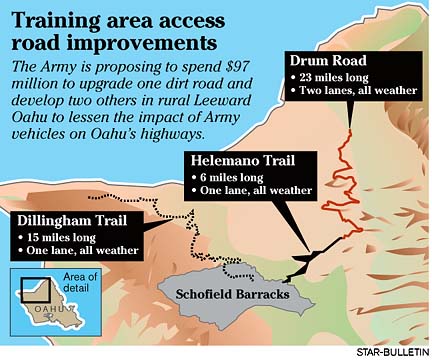


|
A winding dirt and gravel road is a 25th Infantry Division brigade's link to becoming a lethal mobile fight force. Paving a path
to readinessImprovements to a dirt road
become key to Army trainingBy Gregg K. Kakesako
gkakesako@starbulletin.comDrum Road, built probably in 1930s, would be upgraded from Helemano to Kahuku -- one of 32 projects, valued at $693 million, to create interim brigade combat teams at Schofield Barracks, Fort Lewis in Washington, Alaska and Pennsylvania.
Very few, except for those in uniform, have traveled the road from Wahiawa 23 miles into the foothills of the Army's Kahuku training range on the North Shore.
But Drum Road has become important with proposed increases in military vehicles to make the 2nd Brigade a fast-attack force designed to respond to military operations ranging from small scale skirmishes to war. It would take increased traffic to the Kahuku Military Reservation, which also will become a more active training area under the Army's transformation proposals, on the North Shore near Kuilima.
The only route now is busy Kamehameha Highway.
There is more than just military value in the project because Drum Road also could serve as an emergency bypass to the North Shore if Kamehameha Highway is closed again as was the case in 2000 with a rockfall at Waimea.

With the addition of 480 new vehicles -- the majority of them the new eight-wheeled Stryker troop transports -- and nearly 500 more soldiers, the Army realized the need to find a better way to move its troops around Oahu."Adding 480 more Army vehicles would be doubling our vehicular traffic," said Ron Borne, director of the Army's transformation program here. "That's why we are talking about taking them off public roads."
Current transformation plans call for the 25th Division getting the 300 Stryker vehicles in 2005. Fully loaded a Stryker could weigh more than 37 tons and equipped with a 350-horsepower diesel engine, it will go 60 mph. It was built to fit into a C-130 transport. As an infantry carrier, it has room for a nine-man squad and a crew of two. Its 14.5 mm of armor can stop small-arms fire.
That would mean about 20 to 30 more vehicles on the road each week making the trek to the Kahuku training area, increasing to more than a 1,000 at least twice a year when the entire brigade trains as an unit, Borne said.
To meet that demand and to move this traffic off Kamehameha Highway, the Army wants to upgrade Drum Road to allow two lanes of traffic. It would have to be widened and resurfaced, certain blind curves realigned, drainage improved, guardrails built and storm drainage systems built in certain areas because of high amount of rain generated off the Koolau Mountain Range.
The Army also is proposing to build two other roads that would be used only by military vehicles, separating it from the civilian traffic and easing congestion on already highly taxed Leeward Oahu highways. The proposed roads, on lands which the Army does not control, would only be one lane and would run from:
>> Schofield Barracks to Helemano, about six miles, linking it to Drum Road.Borne said the cost of these three access roads will amount to more than $97 million with the Drum Road improvements running as high as $70 million.>> Schofield Barracks to Dillingham Air Field in Mokuleia, about 15 miles using a World War II jeep trail through the Waianae range as a guide.
But the benefits, besides taking military vehicles off island highways, is that Drum Road would be open to use by emergency city vehicles -- such as fire and ambulance -- if Kamehameha Highway is ever inaccessible, Borne said.
He pointed out that two years ago the city had turned to the military for help when Kamehameha Highway near Waimea was closed because of rockslides. At that time Drum Road also was unavailable for use by any type of traffic, even to those in the military with four-wheel drive.
Borne said Drum Road, which now can only accommodate one lane of traffic, wasn't reopened for military use until last summer after construction teams from the 65th Engineers and the 84th Engineers improved the road by taking out ruts caused by erosion.
Borne said Drum Road also will provide a "real world training scenario" as convoys make the four-wheel drive to the Kahukus. "This could be in the form of ambushes or simulated traffic accidents blocking and shutting down the road and making the soldiers vulnerable to attacks in the real world. This type of training could never been done while traveling on a civilian road."
At Kahuku, the Army wants to build several mock city sites to train its soldiers in the art of urban warfare. It also has raised the possibility of buying 1,500 to 2,100 acres south of Schofield Barracks to build a motor pool to house the Strykers and to develop new rifle and pistol ranges.